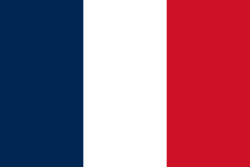
Back الجزائر (المستعمرة الفرنسية) Arabic Colonización francesa d'Arxelia AST Французскі Алжыр Byelorussian Френски Алжир Bulgarian Algèria francesa Catalan Algeria Ffrengig Welsh Fransk Algeriet Danish Γαλλική Αλγερία Greek Franca Alĝerio Esperanto Argelia francesa Spanish
French Algeria | |||||||||||||||
|---|---|---|---|---|---|---|---|---|---|---|---|---|---|---|---|
| 1830–1962 | |||||||||||||||
| Anthem: La Parisienne (1830–1848) Le Chant des Girondins (1848–1852) Partant pour la Syrie (1852–1870) La Marseillaise (1870–1962) | |||||||||||||||
Official Arabic seal of the Governor General of Algeria | |||||||||||||||
 Chronological map of French Algeria's evolution | |||||||||||||||
| Status | 1830–1848: French colony 1848–1962: Part of France | ||||||||||||||
| Capital and largest city | Algiers | ||||||||||||||
| Official languages | French | ||||||||||||||
| Common languages | |||||||||||||||
| Religion | Islam (majority), Roman Catholicism, Judaism | ||||||||||||||
| Governor General | |||||||||||||||
• 1830 (first) | Louis-Auguste-Victor Bourmont | ||||||||||||||
• 1962 (last) | Christian Fouchet | ||||||||||||||
| Legislature | Algerian Assembly (1948–1956) | ||||||||||||||
| History | |||||||||||||||
| 5 July 1830 | |||||||||||||||
| 5 July 1962 | |||||||||||||||
| Area | |||||||||||||||
• Total | 2,381,741 km2 (919,595 sq mi) | ||||||||||||||
| Currency | Budju (1830–1848) (Algerian) Franc (1848–1962) | ||||||||||||||
| |||||||||||||||
French Algeria (French: Alger until 1839, then Algérie afterwards;[1] unofficially Algérie française;[2][3] Arabic: الجزائر المستعمرة), also known as Colonial Algeria, was the period of Algerian history when the country was a colony and later an integral part of France. French rule lasted until the end of the Algerian War which resulted in Algeria's gaining independence on 5 July 1962.
The French conquest of Algeria began in 1830 with the invasion of Algiers which toppled the Regency of Algiers, though Algeria was not fully conquered and pacified until 1903. It is estimated that by 1875, approximately 825,000 indigenous Algerians were killed.[4] Various scholars describe the French conquest as genocide.[5][6][4] Algeria was ruled as a colony from 1830 to 1848, and then as multiple departments, an integral part of France, with the implementing of the Constitution of French Second Republic on 4 November 1848, until Algerian independence in 1962. After a trip to Algiers in 1860, the then-French emperor Napoleon III became keen on establishing a client kingdom which he would in rule in a personal union, expanding freedoms for the indigenous population and limiting colonisation (a stance which he hoped would strengthen France's footing in the Muslim world, but which was unpopular with the local European settlers).[7][8] This project would go nowhere however, and the newly-established Third Republic would scrap any plans for Algerian regional autonomy, even seeking to strengthen its hold by granting citizenship to Algeria's native Jewish population in what has been described as an example of divide and rule.
As a recognized jurisdiction of France, Algeria became a destination for hundreds of thousands of European immigrants. They were first known as colons, and later as pieds-noirs, a term applied primarily to ethnic Europeans born in Algeria. The indigenous Muslim population comprised the majority of the territory throughout its history.[9] Gradually, dissatisfaction among the Muslim population, due to their lack of political and economic freedom, fueled calls for greater political autonomy, and eventually independence from France.[10] The Sétif and Guelma massacre, in 1945, marked a point of no return in Franco-Algerian relations and led to the outbreak of the Algerian War which was characterised by the use of guerrilla warfare by National Liberation Front, and crimes against humanity by the French. The war ended in 1962, with Algeria gaining independence following the Évian Accords in March 1962 and a self-determination referendum in July 1962.
During its last years as part of France, Algeria was a founding member of the European Coal and Steel Community and the European Economic Community.[11]
- ^ Scheiner, Virgile (14 October 1839) Le pays occupé par les Français dans le nord de l'Afrique sera, à l'avenir, désigné sous le nom d'Algérie. (in French)
- ^ Non exhaustive list of ancient and modern books named "Algérie française": (in French) 1848; 1856; 1864; 2007; and so on Archived 2019-02-13 at the Wayback Machine
- ^ African Boundaries. Royal Institute for international affairs. 1979. p. 89. ISBN 9780903983877.
- ^ a b Cite error: The named reference
:2was invoked but never defined (see the help page). - ^ Schaller, Dominik J. (2010). "Genocide and Mass Violence in the 'Heart of Darkness': Africa in the Colonial Period". In Bloxham, Donald; Moses, A. Dirk (eds.). The Oxford Handbook of Genocide Studies. Oxford University Press. p. 356. ISBN 978-0-19-923211-6.
- ^ Gallois, William (2013), Gallois, William (ed.), "An Algerian Genocide?", A History of Violence in the Early Algerian Colony, London: Palgrave Macmillan UK, pp. 145–171, doi:10.1057/9781137313706_7, ISBN 978-1-137-31370-6, retrieved 2024-09-17
- ^ Anceau, Eric. "Napoleon III and Abd el-Kader". napoleon.org.
- ^ "The end of the conquest under Napoleon III and the short-lived Arab Kingdom". Musee de l’armee. Retrieved 31 May 2024.
- ^ "Algeria - Colonial rule". Britannica. Archived from the original on 2024-01-16. Retrieved 2022-11-22.
- ^ Surkis, Judith (15 December 2019). Sex, law, and sovereignty in French Algeria, 1830–1930. Ithaca. ISBN 978-1-5017-3952-1. OCLC 1089839922.
{{cite book}}: CS1 maint: location missing publisher (link) - ^ Hans Groth; Alfonso Sousa-Poza (26 March 2012). Population Dynamics in Muslim Countries: Assembling the Jigsaw. Springer Science & Business Media. p. 227. ISBN 978-3-642-27881-5. Archived from the original on 21 May 2024. Retrieved 23 March 2020.
